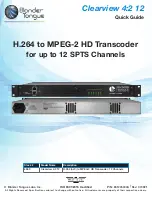
7.2 Mounting the transducer
Important:
Do NOT remove the label attached
to the transducer cable as it contains important
information.
5
7
6
8
1
2
3
4
D13355-1
1
Vessel hull
2
Top half of fairing block
3
Nut
4
Nut and washer (for anti-rotation bolt)
5
Bottom half of fairing block
6
Anti-rotation bolt
7
Transducer
8
Marine grade adhesive sealant — suitable for
submerged applications (not supplied)
1. Ensure an appropriate location for the transducer
has been selected, following the guidelines
provided.
2. Align the bottom half of the fairing block so that it
is parallel to the centerline (keel) of the vessel.
3. Using a permanent marker, draw around the
outside edge of the block and the internal hole for
the threaded tube and anti-rotation bolt.
4. Remove the block from the hull.
5. Drill a pilot hole in the center of the location
marked out on the hull for the threaded tube.
6. Drill the hole out using a suitable size hole cutter.
7. Drill a suitable sized hole for the anti-rotation bolt.
8. Using sandpaper and / or a file ensure there are
no rough edges or burrs.
9. Ensure all surfaces are clean and free from
debris.
10. Apply a thick bead of marine grade adhesive
sealant all around the edge of the top face of the
transducer and the bottom face of the block that
will meet the transducer.
11. Apply a thick bead of marine grade adhesive
sealant up each side of the threaded tube and
anti-rotation bolt, ensuring that the sealant will
protrude approximately 6 mm above the final
tightened nuts.
12. Apply a thick bead of marine grade adhesive
sealant to the head of the anti-rotation bolt where
it will meet the top face of the transducer.
13. Insert the anti-rotation bolt into the anti-rotation
hole so that the hexagonal bolt head sits in the
captive recess located in the bottom of the block.
14. Feed the transducer cable through the bottom
half of the fairing block’s threaded tube hole.
15. Push the block down onto the transducer,
ensuring that the locators on the block line up
with the locator holes on the transducer.
16. Apply a thick bead of marine grade adhesive
sealant all around the edge of the top face of the
bottom half of the block, where it will meet the
hull.
17. Apply a thick bead of marine grade adhesive
sealant all around the edges of the holes in the
hull.
18. Guide the transducer cable, threaded tube and
anti-rotation bolt up through the vessel hull
and ensure the transducer is lined up with the
markings made in step 2.
19. Apply a thick bead of marine grade adhesive
sealant all around the edge of the bottom face of
the top half of the block, where it will meet the
hull.
20. With a person inside the vessel, place the top
half of the block over the threaded tube and
anti-rotation bolt.
21. Place the washer over the anti-rotation bolt.
22. Apply a thick bead of marine grade adhesive
sealant to the bottom edge of the nuts.
23. Ensuring that the block and transducer do
not move, secure the transducer assembly by
tightening the nuts using an adjustable wrench
(spanner).
Note: Wooden hull
— Allow the wooden hull to
swell prior to tightening the nut using the adjustable
spanner.
In order to prevent leaks and transducer
movement when hit by objects or waves, ensure
that the nut is adequately tightened. You should
see the sealant protruding from the edges of all
applied surfaces.
Do NOT overtighten. Overtightening can cause
damage to the transducer and hull which may
result in water leaking into the hull.
24. Remove any excess adhesive sealant.
25. Ensure that the sealant has fully cured before
putting the vessel back in the water.
Refer to the sealant manufacturers instructions
for curing times.
26. Once the vessel has been put back in the water
check for leaks immediately.
27. Check for leaks at regular intervals after
installation until you are satisfied that there are
no leaks.
28. Ensure checking for leaks around the transducer
is added to your vessel’s routine maintenance
schedule.
34
CPT-70 / CPT-80 / CPT-110 / CPT-120
Summary of Contents for DownVision CPT-70
Page 2: ......
Page 4: ......
Page 6: ...6 CPT 70 CPT 80 CPT 110 CPT 120...
Page 12: ...12 CPT 70 CPT 80 CPT 110 CPT 120...
Page 36: ...36 CPT 70 CPT 80 CPT 110 CPT 120...
Page 37: ...Chapter 8 Troubleshooting Chapter contents 8 1 Troubleshooting on page 38 Troubleshooting 37...
Page 40: ...40 CPT 70 CPT 80 CPT 110 CPT 120...
Page 49: ......
Page 50: ...www raymarine com...
















































